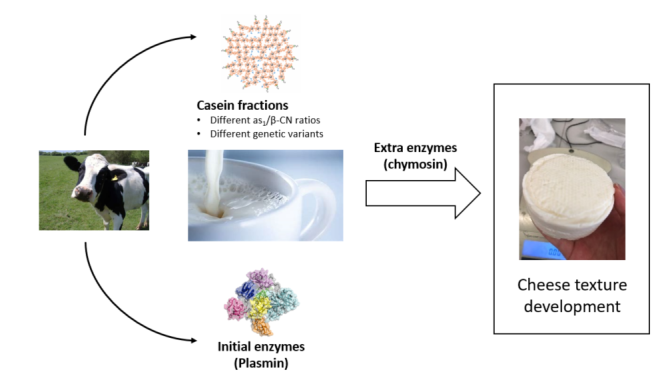Project
Engineering of cheese texture by modifying casein fractions and proteolytic enzymes
The final texture of cheese is affected by several compositional parameters of the milk, which determine the composition of the curd(Lamichhane, Kelly et al. 2018). Curd parameters such as fat, protein and water content, concentration of calcium, phosphate and salt, pH, and the presence of proteolytic enzymes have an influence on the texture of the end product. Additionally, the ripening conditions, which control the evolution of the compositional parameters and the activity of the proteolytic enzymes entrapped in the curd, will also influence the final textural properties of the cheese(Sousa, Ardö et al. 2001). Concerning the end product, texture is determined the most by the moisture, fat and calcium content, and by the ratio between intact (non-hydrolysed) casein fractions, mainly αs1- and β-casien. While compositional parameters of the curd can be controlled by changes in the production process, the activity of proteolytic enzymes is often the results of factors that are not deliberately regulated. These factors are the unintentional effect of specific steps in the production process. As a result, different cheese-making technologies are bound to specific production lines and technological designs. This limits the production flexibility of cheese factories, as certain cheeses can be produced only in certain factories.
In a cheese factory of the future, from a production flexibility point of view, it would be desirable to dispose of guidelines allowing to obtain curds with specific compositional parameters, including enzymes activity, independently of the available production equipment. These guidelines would also be of enormous value for the developments of new products: the production process of a cheese with a desired texture could be designed without the need for many trial-and-error practical experiments. The availability of the mentioned guidelines would result in an advantage for the Chinese dairy industry in designing innovative cheese production processes.
Aim
The aim of this study is to estimate the potential to control the cheese texture by modulating the ratio between specific casein fractions (αs1/β-casein) and the content of the proteolytic enzymes in the curd.
Approach
Model cheese will be produced starting from milk in which the casein fractions and also enzymes will be varied in a systematic way. A standard preparation procedure will be optimised to produce model cheese. The microstructure and mechanical properties of the obtained model cheese will be characterised, as well as their chemical composition. This will be done also during ripening of the model cheese. Relations among these properties will be analysed.
Implications
• Cheese production flexibility
• Developments of new products
• Cheese texture prediction during ripening
References
1. Lamichhane, P., A. L. Kelly and J. J. Sheehan (2018). "Symposium review: Structure-function relationships in cheese." Journal of Dairy Science 101(3): 2692-2709.
2. Sousa, M. J., Y. Ardö and P. L. H. McSweeney (2001). "Advances in the study of proteolysis during cheese ripening." International Dairy Journal 11(4): 327-345.
